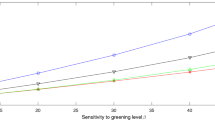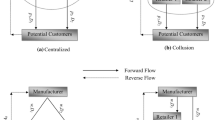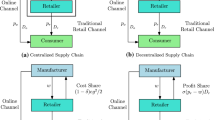Appendix A
Proof of Proposition 1
We first solve for the retailer’s \(\alpha \)-profit.
$$\begin{aligned} \max \limits _{p} \Pi _{r}(p)&= (p-w)(\Phi ^{-1}(1-\alpha )-\Psi _{1}^{-1}(\alpha )p\nonumber \\&+\,\Psi _{2}^{-1}(1-\alpha )\theta ). \end{aligned}$$
(24)
$$\begin{aligned} \frac{\partial }{\partial p}\Pi _{r}&= \Phi ^{-1}(1-\alpha )-2\Psi _{1}^{-1}(\alpha )p+\Psi _{1}^{-1}(\alpha )w\nonumber \\&+\,\Psi _{2}^{-1}(1-\alpha )\theta . \end{aligned}$$
(25)
$$\begin{aligned} \frac{\partial ^{2} }{\partial ^{2} p}\Pi _{r}&= -2\Psi _{1}^{-1}(\alpha )<0. \end{aligned}$$
(26)
Therefore, the retailer’s \(\alpha \)-profit function is strictly concave about p. Let the first-order condition equate to 0, we have
$$\begin{aligned} p=\frac{\Phi ^{-1}(1-\alpha )+\Psi _{1}^{-1}(\alpha )w+\Psi _{2}^{-1}(1-\alpha )\theta }{2\Psi _{1}^{-1}(\alpha )}. \end{aligned}$$
(27)
The manufacturer’s profit function is
$$\begin{aligned} \max \limits _{(w,\theta )}\Pi _{m}&= (w-c)(\Phi ^{-1}(1-\alpha )-\Psi _{1}^{-1}(\alpha )p\nonumber \\&+\,\Psi _{2}^{-1}(1-\alpha )\theta )-I\theta ^{2}. \end{aligned}$$
(28)
We substitute p into equation (28) and derive
$$\begin{aligned} \max \limits _{(w,\theta )}\Pi _{m}& = \frac{(w-c)(\Phi ^{-1}(1-\alpha )-\Psi _{1}^{-1}(\alpha )w+\Psi _{2}^{-1}(1-\alpha )\theta )}{2}\nonumber \\& \quad -I\theta ^{2}. \end{aligned}$$
(29)
The first-order condition
$$\begin{aligned} \frac{\partial }{\partial w}\Pi _{m}&= -\Psi _{1}^{-1}(\alpha )w+\frac{\Phi ^{-1}(1-\alpha )}{2}\nonumber \\&+\frac{\Psi _{1}^{-1}(\alpha )c}{2}+\frac{\Psi _{2}^{-1}(1-\alpha )\theta }{2}, \end{aligned}$$
(30)
$$\begin{aligned} \frac{\partial }{\partial \theta }\Pi _{m}&= \frac{(w-c)\Psi _{2}^{-1}(1-\alpha )}{2}-2I\theta . \end{aligned}$$
(31)
The second-order condition
$$\begin{aligned} \frac{\partial ^{2} }{\partial w^{2}}\Pi _{m}&= -\Psi _{1}^{-1}(\alpha )<0, \end{aligned}$$
(32)
$$\begin{aligned} \frac{\partial ^{2} }{\partial \theta ^{2}}\Pi _{m}&= -2I<0,\end{aligned}$$
(33)
$$\begin{aligned} \frac{\partial ^{2} }{\partial w \partial \theta }\Pi _{m}&= \frac{\Psi _{2}^{-1}(1-\alpha )}{2}. \end{aligned}$$
(34)
when \(2I\Psi _{1}^{-1}(\alpha )-\frac{\Psi _{2}^{-1}(1-\alpha )^{2}}{4}>0\), the Hessian H is negative definite. Thus the manufacturer’s profit function is jointly concave in w and \(\theta \). Let the first-order condition equate to 0, we have
$$\begin{aligned} w(\theta )&= \frac{\Phi ^{-1}(1-\alpha )+\Psi _{1}^{-1}(\alpha )c+\Psi _{2}^{-1}(1-\alpha )\theta }{2\Psi _{1}^{-1}(\alpha )}, \end{aligned}$$
(35)
$$\begin{aligned} \theta (w)&= \frac{(w-c)\Psi _{2}^{-1}(1-\alpha )}{4I}. \end{aligned}$$
(36)
And we have
$$\begin{aligned} \theta ^{D}&= \frac{\Psi _{2}^{-1}(1-\alpha )(\Phi ^{-1}(1-\alpha )-\Psi _{1}^{-1}(\alpha )c)}{8I\Psi _{1}^{-1}(\alpha )-(\Psi _{2}^{-1}(1-\alpha ))^{2}}, \end{aligned}$$
(37)
$$\begin{aligned} w^{D}&= \frac{4I(\Phi ^{-1}(1-\alpha )-\Psi _{1}^{-1}(\alpha )c)}{8I\Psi _{1}^{-1}(\alpha )-(\Psi _{2}^{-1}(1-\alpha ))^{2}}+c,\end{aligned}$$
(38)
$$\begin{aligned} p^{D}&= \frac{6I(\Phi ^{-1}(1-\alpha )-\Psi _{1}^{-1}(\alpha )c)}{8I\Psi _{1}^{-1}(\alpha )-(\Psi _{2}^{-1}(1-\alpha ))^{2}}+c,\end{aligned}$$
(39)
$$\begin{aligned} \Pi _{m}^{D}&= \frac{I(\Phi ^{-1}(1-\alpha )-\Psi _{1}^{-1}(\alpha )c)^{2}}{8I\Psi _{1}^{-1}(\alpha )-(\Psi _{2}^{-1}(1-\alpha ))^{2}}, \end{aligned}$$
(40)
$$\begin{aligned} \Pi _{r}^{D}&= \frac{4\Psi _{1}^{-1}(\alpha )I^{2}(\Phi ^{-1}(1-\alpha )-\Psi _{1}^{-1}(\alpha )c)^{2}}{(8I\Psi _{1}^{-1}(\alpha )-(\Psi _{2}^{-1}(1-\alpha ))^{2})^{2}}, \end{aligned}$$
(41)
$$\begin{aligned} \Pi _{s}^{D}&= \frac{I(\Phi ^{-1}(1-\alpha )-\Psi _{1}^{-1}(\alpha )c)^{2}(12I\Psi _{1}^{-1}(\alpha )-\Psi _{2}^{-1}(1-\alpha )^{2})}{(8I\Psi _{1}^{-1}(\alpha )-(\Psi _{2}^{-1}(1-\alpha ))^{2})^{2}}. \end{aligned}$$
(42)
\(\square \)
Proof of Proposition 2
The partial derivative w.r.t. I gives
$$\begin{aligned} \frac{\delta \theta ^{D}}{\delta I}&= \frac{-8\Psi _{1}^{-1}(\alpha )\Psi _{2}^{-1}(1-\alpha )(\Phi ^{-1}(1-\alpha )-\Psi _{1}^{-1}(\alpha )c)}{(8I\Psi _{1}^{-1}(\alpha )-(\Psi _{2}^{-1}(1-\alpha ))^{2})^{2}}< 0. \end{aligned}$$
(43)
$$\begin{aligned} \frac{\delta w^{D}}{\delta I}&= \frac{-4(\Psi _{1}^{-1}(\alpha ))^{2}(\Phi ^{-1}(1-\alpha )-\Psi _{1}^{-1}(\alpha )c)}{(8I\Psi _{1}^{-1}(\alpha )-(\Psi _{2}^{-1}(1-\alpha ))^{2})^{2}}< 0. \end{aligned}$$
(44)
$$\begin{aligned} \frac{\delta p^{D}}{\delta I}&= \frac{-6(\Psi _{1}^{-1}(\alpha ))^{2}(\Phi ^{-1}(1-\alpha )-\Psi _{1}^{-1}(\alpha )c)}{(8I\Psi _{1}^{-1}(\alpha )-(\Psi _{2}^{-1}(1-\alpha ))^{2})^{2}}< 0. \end{aligned}$$
(45)
$$\begin{aligned} \frac{\delta \Pi _{m}^{D}}{\delta I}&= \frac{-(\Psi _{1}^{-1}(\alpha ))^{2}(\Phi ^{-1}(1-\alpha )-\Psi _{1}^{-1}(\alpha )c)^{2}}{(8I\Psi _{1}^{-1}(\alpha )-(\Psi _{2}^{-1}(1-\alpha ))^{2})^{2}}\nonumber \\&< 0. \end{aligned}$$
(46)
$$\begin{aligned} \frac{\delta \Pi _{r}^{D}}{\delta I}&= \frac{-8I(\Psi _{1}^{-1}(\alpha ))^{2}(\Phi ^{-1}(1-\alpha )-\Psi _{1}^{-1}(\alpha )c)^{2}(8I\Psi _{1}^{-1}(\alpha )-(\Psi _{2}^{-1}(1-\alpha ))^{2})}{(8I\Psi _{1}^{-1}(\alpha )-(\Psi _{2}^{-1}(1-\alpha ))^{2})^{4}}\nonumber \\&< 0. \end{aligned}$$
(47)
$$\begin{aligned} \frac{\delta \Pi _{s}^{D}}{\delta I}&= \frac{(\Phi ^{-1}(1-\alpha )-\Psi _{1}^{-1}(\alpha )c)^{2}(8I\Psi _{1}^{-1}(\alpha )-(\Psi _{2}^{-1}(1-\alpha ))^{2})((\Psi _{2}^{-1}(1-\alpha ))^{2}-16I\Psi _{1}^{-1}(\alpha ))}{(8I\Psi _{1}^{-1}(\alpha )-(\Psi _{2}^{-1}(1-\alpha ))^{2})^{4}}\nonumber \\&< 0. \end{aligned}$$
(48)
\(\square \)
Proof of Proposition 3
In a centralized channel, we solve for the supply chain’s \(\alpha \)-profit function,
$$\begin{aligned} \max \limits _{(p,\theta )}\Pi _{s}&= (p-c)(\Phi ^{-1}(1-\alpha )-\Psi _{1}^{-1}(\alpha )p\nonumber \\&+\Psi _{2}^{-1}(1-\alpha )\theta )-I\theta ^{2}. \end{aligned}$$
(49)
$$\begin{aligned} \frac{\partial }{\partial p}\Pi _{s}&= \frac{\Phi ^{-1}(1-\alpha )-2\Psi _{1}^{-1}(\alpha )p+\Psi _{1}^{-1}(\alpha )c+\Psi _{2}^{-1}(1-\alpha )\theta }{2\Psi _{1}^{-1}}, \end{aligned}$$
(50)
$$\begin{aligned} \frac{\partial }{\partial \theta }\Pi _{s}&= (p-c)\Psi _{2}^{-1}(1-\alpha )-2I\theta . \end{aligned}$$
(51)
Let the first-order condition equate to 0, we have
$$\begin{aligned} \theta ^{C}&= \frac{\Psi _{2}^{-1}(1-\alpha )(\Phi ^{-1}(1-\alpha )-\Psi _{1}^{-1}(\alpha )c)}{4I\Psi _{1}^{-1}(\alpha )-(\Psi _{2}^{-1}(1-\alpha ))^{2}}, \end{aligned}$$
(52)
$$\begin{aligned} p^{C}&= \frac{2I(\Phi ^{-1}(1-\alpha )-\Psi _{1}^{-1}(\alpha )c)}{4I\Psi _{1}^{-1}(\alpha )-(\Psi _{2}^{-1}(1-\alpha ))^{2}}+c, \end{aligned}$$
(53)
$$\begin{aligned} \Pi _{s}^{C}&= \frac{I(\Phi ^{-1}(1-\alpha )-\Psi _{1}^{-1}(\alpha )c)^{2}}{4I\Psi _{1}^{-1}(\alpha )-(\Psi _{2}^{-1}(1-\alpha ))^{2}}. \end{aligned}$$
(54)
\(\square \)
Proof of Proposition 4
The partial derivative w.r.t. I gives
$$\begin{aligned} \frac{\delta \theta ^{C}}{\delta I}&= \frac{-4\Psi _{1}^{-1}(\alpha )\Psi _{2}^{-1}(1-\alpha )(\Phi ^{-1}(1-\alpha )-\Psi _{1}^{-1}(\alpha )c)}{(4I\Psi _{1}^{-1}(\alpha )-(\Psi _{2}^{-1}(1-\alpha ))^{2})^{2}}< 0. \end{aligned}$$
(55)
$$\begin{aligned} \frac{\delta p^{C}}{\delta I}&= \frac{-2(\Psi _{1}^{-1}(\alpha ))^{2}(\Phi ^{-1}(1-\alpha )-\Psi _{1}^{-1}(\alpha )c)}{(8I\Psi _{1}^{-1}(\alpha )-(\Psi _{2}^{-1}(1-\alpha ))^{2})^{2}}< 0. \end{aligned}$$
(56)
$$\begin{aligned} \frac{\delta \Pi _{s}^{C}}{\delta I}&= \frac{-(\Psi _{1}^{-1}(\alpha ))^{2}(\Phi ^{-1}(1-\alpha )-\Psi _{1}^{-1}(\alpha )c)^{2}}{(8I\Psi _{1}^{-1}(\alpha )-(\Psi _{2}^{-1}(1-\alpha ))^{2})^{2}}< 0. \end{aligned}$$
(57)
\(\square \)
Proof of Proposition 5
$$\begin{aligned} \theta ^{C}-\theta ^{D}&= \frac{\Psi _{2}^{-1}(1-\alpha )(\Phi ^{-1}(1-\alpha )-\Psi _{1}^{-1}(\alpha )c)}{4I\Psi _{1}^{-1}(\alpha )-(\Psi _{2}^{-1}(1-\alpha ))^{2}} -\frac{\Psi _{2}^{-1}(1-\alpha )(\Phi ^{-1}(1-\alpha )-\Psi _{1}^{-1}(\alpha )c)}{8I\Psi _{1}^{-1}(\alpha )-(\Psi _{2}^{-1}(1-\alpha ))^{2}}\\&= \frac{4I\Psi _{1}^{-1}(\alpha )\Psi _{2}^{-1}(1-\alpha )(\Phi ^{-1}(1-\alpha )-\Psi _{1}^{-1}(\alpha )c)}{(4I\Psi _{1}^{-1}(\alpha )-(\Psi _{2}^{-1}(1-\alpha ))^{2}) (8I\Psi _{1}^{-1}(\alpha )-(\Psi _{2}^{-1}(1-\alpha ))^{2})}\\&\ge 0. \\ p^{C}-p^{D}&= \frac{2I(\Phi ^{-1}(1-\alpha )-\Psi _{1}^{-1}(\alpha )c)}{4I\Psi _{1}^{-1}(\alpha )-(\Psi _{2}^{-1}(1-\alpha ))^{2}} -\frac{6I(\Phi ^{-1}(1-\alpha )-\Psi _{1}^{-1}(\alpha )c)}{8I\Psi _{1}^{-1}(\alpha )-(\Psi _{2}^{-1}(1-\alpha ))^{2}}\\&= \frac{4I(\Phi ^{-1}(1-\alpha )-\Psi _{1}^{-1}(\alpha )c)((\Psi _{2}^{-1}(1-\alpha ))^{2})-2I\Psi _{1}^{-1}(\alpha )}{(4I\Psi _{1}^{-1}(\alpha )-(\Psi _{2}^{-1}(1-\alpha ))^{2}) (8I\Psi _{1}^{-1}(\alpha )-(\Psi _{2}^{-1}(1-\alpha ))^{2})}\\&\le .\\ \Pi _{s}^{C}-\Pi _{s}^{D}&= \frac{I(\Phi ^{-1}(1-\alpha )-\Psi _{1}^{-1}(\alpha )c)^{2}}{4I\Psi _{1}^{-1}(\alpha )-(\Psi _{2}^{-1}(1-\alpha ))^{2}} -\frac{I(\Phi ^{-1}(1-\alpha )-\Psi _{1}^{-1}(\alpha )c)^{2}(12I\Psi _{1}^{-1}(\alpha )-(\Psi _{2}^{-1}(1-\alpha ))^{2})}{(8I\Psi _{1}^{-1}(\alpha )-(\Psi _{2}^{-1}(1-\alpha ))^{2})^{2}}\\&= \frac{16I^{3}\Psi _{1}^{-1}(\alpha )^{2}(\Phi ^{-1}(1-\alpha )-\Psi _{1}^{-1}(\alpha )c)^{2}}{(4I\Psi _{1}^{-1}(\alpha )-(\Psi _{2}^{-1}(1-\alpha ))^{2}) (8I\Psi _{1}^{-1}(\alpha )-(\Psi _{2}^{-1}(1-\alpha ))^{2})^{2}}\\& \ge 0. \end{aligned}$$
\(\square \)
Proof of Proposition 6
The \(\alpha \)-profit functions of the retailer and manufacturer are
$$\begin{aligned} \Pi _{r}&= (p-w)(\Phi ^{-1}(1-\alpha )-\Psi _{1}^{-1}(\alpha )p\nonumber \\&+\,\Psi _{2}^{-1}(1-\alpha )\theta )-(1-\phi ) I\theta ^{2}, \end{aligned}$$
(58)
$$\begin{aligned} \Pi _{m}&= (w-c)(\Phi ^{-1}(1-\alpha )-\Psi _{1}^{-1}(\alpha )p\nonumber \\&+\,\Psi _{2}^{-1}(1-\alpha )\theta )-\phi I\theta ^{2}. \end{aligned}$$
(59)
We first solve the first-order condition of the retailer’s profit function:
$$\begin{aligned} \frac{\partial }{\partial p}\Pi _{r}&= \Phi ^{-1}(1-\alpha )-2\Psi _{1}^{-1}(\alpha )p\nonumber \\&+\,\Psi _{1}^{-1}(\alpha )w+\Psi _{2}^{-1}(1-\alpha )\theta . \end{aligned}$$
(60)
The second-order condition
$$\begin{aligned} \frac{\partial ^{2} }{\partial p^{2}}\Pi _{r}=-2\Psi _{1}^{-1}(\alpha )<0. \end{aligned}$$
(61)
Therefore, the retailer’s profit function is strictly concave. Let the first-order condition equate to 0, we have
$$\begin{aligned} p=\frac{\Phi ^{-1}(1-\alpha )+\Psi _{1}^{-1}(\alpha )w+\Psi _{2}^{-1}(1-\alpha )\theta }{2\Psi _{1}^{-1}}. \end{aligned}$$
(62)
Substitute p into equation (62) and derive
$$\begin{aligned} \Pi _{m}&= \frac{(w-c)(\Phi ^{-1}(1-\alpha )-\Psi _{1}^{-1}(\alpha )w+\Psi _{2}^{-1}(1-\alpha )\theta )}{2}\nonumber \\&-\phi I\theta ^{2}. \end{aligned}$$
(63)
$$\begin{aligned} \frac{\partial }{\partial w}\Pi _{m}&= -\Psi _{1}^{-1}(\alpha )w+\frac{\Phi ^{-1}(1-\alpha )}{2} +\frac{\Psi _{1}^{-1}(\alpha )c}{2}\nonumber \\&+\frac{\Psi _{2}^{-1}(1-\alpha )\theta }{2}, \end{aligned}$$
(64)
$$\begin{aligned} \frac{\partial }{\partial \theta }\Pi _{m}&= \frac{(w-c)\Psi _{2}^{-1}(1-\alpha )}{2}-2I\theta \phi . \end{aligned}$$
(65)
$$\begin{aligned} \frac{\partial ^{2} }{\partial w^{2}}\Pi _{m}&= -\Psi _{1}^{-1}(\alpha )<0,\end{aligned}$$
(66)
$$\begin{aligned} \frac{\partial ^{2} }{\partial \theta ^{2}}\Pi _{m}&= -2I\phi <0, \end{aligned}$$
(67)
$$\begin{aligned} \frac{\partial ^{2} }{\partial w \partial \theta }\Pi _{m}&= \frac{\Psi _{2}^{-1}(1-\alpha )}{2}. \end{aligned}$$
(68)
when \(2I\Psi _{1}^{-1}(\alpha )\phi -\frac{\Psi _{2}^{-1}(1-\alpha )^{2}}{4}>0\), the Hessian H is negative definite. Let the first-order conditions equate to 0, we have
$$\begin{aligned} w(\theta )&= \frac{\Phi ^{-1}(1-\alpha )+\Psi _{1}^{-1}(\alpha )c+\Psi _{2}^{-1}(1-\alpha )\theta }{2\Psi _{1}^{-1}(\alpha )}, \end{aligned}$$
(69)
$$\begin{aligned} \theta (w)&= \frac{(w-c)\Psi _{2}^{-1}(1-\alpha )}{4I\phi }. \end{aligned}$$
(70)
Substituting w into \(\theta \), we have
$$\begin{aligned} \theta =\frac{\Psi _{2}^{-1}(1-\alpha )(\Phi ^{-1}(1-\alpha )-\Psi _{1}^{-1}(\alpha )c)}{8I\Psi _{1}^{-1}(\alpha )\phi -(\Psi _{2}^{-1}(1-\alpha ))^{2}}, \end{aligned}$$
(71)
And
$$\begin{aligned} w&= \frac{4I\phi (\Phi ^{-1}(1-\alpha )+\Psi _{1}^{-1}(\alpha )c)-(\Psi _{2}^{-1}(1-\alpha ))^{2}c}{8I\Psi _{1}^{-1}(\alpha )\phi -(\Psi _{2}^{-1}(1-\alpha ))^{2}}, \end{aligned}$$
(72)
$$\begin{aligned} p&= \frac{2I\phi (3\Phi ^{-1}(1-\alpha )+\Psi _{1}^{-1}(\alpha ))-(\Psi _{2}^{-1}(1-\alpha ))^{2}c}{8I\Psi _{1}^{-1}(\alpha )\phi -(\Psi _{2}^{-1}(1-\alpha ))^{2}}. \end{aligned}$$
(73)
Substituting the above values in the retailer’s profit function, we have
$$\begin{aligned}&\Pi _{r}=\frac{4I^{2}\phi ^{2}(\Phi ^{-1}(1-\alpha )-\Psi _{1}^{-1}(\alpha )c)^{2}}{(8I\Psi _{1}^{-1}(\alpha )\phi -(\Psi _{2}^{-1}(1-\alpha ))^{2})^{2}}-(1-\phi )\nonumber \\&\quad \frac{I(\Psi _{2}^{-1}(1-\alpha ))^{2}(\Phi ^{-1}(1-\alpha )+\Psi _{1}^{-1}(\alpha )c)^{2}}{(8I\Psi _{1}^{-1}(\alpha )\phi -(\Psi _{2}^{-1}(1-\alpha ))^{2})^{2}}. \end{aligned}$$
(74)
The first-order condition
$$\begin{aligned} \frac{\partial }{\partial \phi }\Pi _{r}=\frac{I(\Psi _{2}^{-1}(1-\alpha ))^{2}(\Phi ^{-1}(1-\alpha )-\Psi _{1}^{-1}(\alpha )c)^{2}((\Psi _{2}^{-1}(1-\alpha ))^{2}-16I\Psi _{1}^{-1}(\alpha )(1-\phi ))}{(8I\Psi _{1}^{-1}(\alpha )\phi -(\Psi _{2}^{-1}(1-\alpha ))^{2})^{3}}. \end{aligned}$$
(75)
The second-order condition
$$\begin{aligned} \small \frac{\partial ^{2} }{\partial \phi ^{2} }\Pi _{r}=\frac{8I^{2}(\Psi _{2}^{-1}(1-\alpha ))^{2}\Psi _{1}^{-1}(\alpha )(\Phi ^{-1}(1-\alpha )-\Psi _{1}^{-1}(\alpha )c)^{2}(5(\Psi _{2}^{-1}(1-\alpha ))^{2}- 16I\Psi _{1}^{-1}(\alpha )(3-2\phi ))}{(8I\Psi _{1}^{-1}(\alpha )\phi -(\Psi _{2}^{-1}(1-\alpha ))^{2})^{4}}. \end{aligned}$$
(76)
when \(5(\Psi _{2}^{-1}(1-\alpha ))^{2}- 16I\Psi _{1}^{-1}(\alpha )(3-2\phi )<0\), the retailer’s profit function is strictly concave in \(\phi \). Therefore, using the first-order conditions to obtain the optimal \(\phi \), we have
$$\begin{aligned} \phi ^{*}= \frac{(\Psi _{2}^{-1}(1-\alpha ))^{2}}{16I\Psi _{1}^{-1}(\alpha )}. \end{aligned}$$
(77)
Substituting the value of \(\phi ^{*}\) in the above expressions, we get
$$\begin{aligned} \theta ^{*}&= \frac{2\Psi _{2}^{-1}(1-\alpha )(\Phi ^{-1}(1-\alpha )-\Psi _{1}^{-1}(\alpha )c)}{16I\Psi _{1}^{-1}(\alpha )-3(\Psi _{2}^{-1}(1-\alpha ))^{2}}, \end{aligned}$$
(78)
$$\begin{aligned} w^{*}&= \frac{16I\Psi _{1}^{-1}(\alpha )(\Phi ^{-1}(1-\alpha )+\Psi _{1}^{-1}(\alpha )c)-(\Psi _{2}^{-1}(1-\alpha ))^{2}(\Phi ^{-1}(1-\alpha )+ 5\Psi _{1}^{-1}(\alpha )c)}{2\Psi _{1}^{-1}(\alpha )(16I\Psi _{1}^{-1}(\alpha )-3(\Psi _{2}^{-1}(1-\alpha ))^{2})}, \end{aligned}$$
(79)
$$\begin{aligned} p^{*}&= \frac{16I\Psi _{1}^{-1}(\alpha )(3\Phi ^{-1}(1-\alpha )+\Psi _{1}^{-1}(\alpha ))-3(\Psi _{2}^{-1}(1-\alpha ))^{2}(\Phi ^{-1}(1-\alpha )+ 3\Psi _{1}^{-1}(\alpha )c)}{4\Psi _{1}^{-1}(\alpha )(16I\Psi _{1}^{-1}(\alpha )-3(\Psi _{2}^{-1}(1-\alpha ))^{2})}, \end{aligned}$$
(80)
$$\begin{aligned} \Pi _{m}^{*}&= \frac{(\Phi ^{-1}(1-\alpha )-\Psi _{1}^{-1}(\alpha )c)^{2}(16I\Psi _{1}^{-1}(\alpha )-(\Psi _{2}^{-1}(1-\alpha ))^{2})}{8\Psi _{1}^{-1}(\alpha )(16I\Psi _{1}^{-1}(\alpha )-3(\Psi _{2}^{-1}(1-\alpha ))^{2})}, \end{aligned}$$
(81)
$$\begin{aligned} \Pi _{r}^{*}&= \frac{(\Phi ^{-1}(1-\alpha )-\Psi _{1}^{-1}(\alpha )c)^{2}(16I\Psi _{1}^{-1}(\alpha )+(\Psi _{2}^{-1}(1-\alpha ))^{2})}{16\Psi _{1}^{-1}(\alpha )(16I\Psi _{1}^{-1}(\alpha )-3(\Psi _{2}^{-1}(1-\alpha ))^{2})}, \end{aligned}$$
(82)
$$\begin{aligned} \Pi _{s}^{*}&= \frac{(\Phi ^{-1}(1-\alpha )-\Psi _{1}^{-1}(\alpha )c)^{2}(48I\Psi _{1}^{-1}(\alpha )-(\Psi _{2}^{-1}(1-\alpha ))^{2})}{16\Psi _{1}^{-1}(\alpha )(16I\Psi _{1}^{-1}(\alpha )-3(\Psi _{2}^{-1}(1-\alpha ))^{2})}. \end{aligned}$$
(83)
\(\square \)
Proof of Proposition 7
The partial derivative of \(\phi ^{*}\) w.r.t. I gives
$$\begin{aligned} \frac{\delta \phi ^{*}}{\delta I}=\frac{-16(\Psi _{2}^{-1}(1-\alpha ))^{2}\Psi _{1}^{-1}(\alpha )}{(16I\Psi _{1}^{-1}(\alpha ))^{2}}< 0. \end{aligned}$$
(84)
\(\square \)
Proof of Proposition 8
$$\begin{aligned} \theta ^{*}-\theta ^{D}&= \frac{2\Psi _{2}^{-1}(1-\alpha )(\Phi ^{-1}(1-\alpha )-\Psi _{1}^{-1}(\alpha )c)}{16I\Psi _{1}^{-1}(\alpha )-3(\Psi _{2}^{-1}(1-\alpha ))^{2}} -\frac{\Psi _{2}^{-1}(1-\alpha )(\Phi ^{-1}(1-\alpha )- \Psi _{1}^{-1}(\alpha )c)}{8I\Psi _{1}^{-1}(\alpha )-(\Psi _{2}^{-1}(1-\alpha ))^{2}}\\&= \frac{(\Psi _{2}^{-1}(1-\alpha ))^{3}(\Phi ^{-1}(1-\alpha )-\Psi _{1}^{-1}(\alpha )c)^{2}}{(16I\Psi _{1}^{-1}(\alpha )-3(\Psi _{2}^{-1}(1-\alpha ))^{2}) (8I\Psi _{1}^{-1}(\alpha )-(\Psi _{2}^{-1}(1-\alpha ))^{2})}\\& \ge 0.\\ w^{*}-w^{D}&= \frac{16I\Psi _{1}^{-1}(\alpha )(\Phi ^{-1}(1-\alpha )+\Psi _{1}^{-1}(\alpha )c)-(\Psi _{2}^{-1}(1-\alpha ))^{2}(\Phi ^{-1}(1-\alpha )+ 5\Psi _{1}^{-1}(\alpha )c)}{2\Psi _{1}^{-1}(\alpha )(16I\Psi _{1}^{-1}(\alpha )-3(\Psi _{2}^{-1}(1-\alpha ))^{2})}\\&\quad -\frac{4I(\Phi ^{-1}(1-\alpha )-\Psi _{1}^{-1}(\alpha )c)}{8I\Psi _{1}^{-1}(\alpha )-(\Psi _{2}^{-1}(1-\alpha ))^{2}}-c\\&= \frac{(\Psi _{2}^{-1}(1-\alpha ))^{4}(\Phi ^{-1}(1-\alpha )-\Psi _{1}^{-1}(\alpha )c)}{2\Psi _{1}^{-1}(\alpha )(16I\Psi _{1}^{-1}(\alpha )-3(\Psi _{2}^{-1}(1-\alpha ))^{2}) (8I\Psi _{1}^{-1}(\alpha )-(\Psi _{2}^{-1}(1-\alpha ))^{2})}\\& \ge 0.\\ p^{*}-p^{D}&= \frac{16I\Psi _{1}^{-1}(\alpha )(3\Phi ^{-1}(1-\alpha )+\Psi _{1}^{-1}(\alpha ))-3(\Psi _{2}^{-1}(1-\alpha ))^{2}(\Phi ^{-1}(1-\alpha )+ 3\Psi _{1}^{-1}(\alpha )c)}{4\Psi _{1}^{-1}(\alpha )(16I\Psi _{1}^{-1}(\alpha )-3(\Psi _{2}^{-1}(1-\alpha ))^{2})}\\&\quad -\frac{6I(\Phi ^{-1}(1-\alpha )-\Psi _{1}^{-1}(\alpha )c)}{8I\Psi _{1}^{-1}(\alpha )-(\Psi _{2}^{-1}(1-\alpha ))^{2}}-c\\&= \frac{3(\Psi _{2}^{-1}(1-\alpha ))^{4}(\Phi ^{-1}(1-\alpha )-\Psi _{1}^{-1}(\alpha )c)}{4\Psi _{1}^{-1}(\alpha )(16I\Psi _{1}^{-1}(\alpha )-3(\Psi _{2}^{-1}(1-\alpha ))^{2}) (8I\Psi _{1}^{-1}(\alpha )-(\Psi _{2}^{-1}(1-\alpha ))^{2})}\\& \ge 0. \end{aligned}$$
\(\square \)
Proof of Proposition 9
$$\begin{aligned} \Pi _{r}^{*}-\Pi _{r}^{D}&= \frac{(16I\Psi _{1}^{-1}(\alpha )+(\Psi _{2}^{-1}(1-\alpha ))^{2})((\Phi ^{-1}(1-\alpha )-\Psi _{1}^{-1}(\alpha )c))^{2}}{16\Psi _{1}^{-1}(\alpha )(16I\Psi _{1}^{-1}(\alpha )-3(\Psi _{2}^{-1}(1-\alpha ))^{2})} - \frac{4I^{2}\Psi _{1}^{-1}(\alpha )(\Phi ^{-1}(1-\alpha )-\Psi _{1}^{-1}(\alpha )c)^{2}}{8I\Psi _{1}^{-1}(\alpha )-(\Psi _{2}^{-1}(1-\alpha ))^{2}}-c\\&= \frac{(\Psi _{2}^{-1}(1-\alpha ))^{6}(\Phi ^{-1}(1-\alpha )-\Psi _{1}^{-1}(\alpha )c)^{2}}{16\Psi _{1}^{-1}(\alpha )(16I\Psi _{1}^{-1}(\alpha )-3(\Psi _{2}^{-1}(1-\alpha ))^{2}) (8I\Psi _{1}^{-1}(\alpha )-(\Psi _{2}^{-1}(1-\alpha ))^{2})}\\& \ge 0.\\ \Pi _{m}^{*}-\Pi _{m}^{D}&= \frac{(16I\Psi _{1}^{-1}(\alpha )-(\Psi _{2}^{-1}(1-\alpha ))^{2})((\Phi ^{-1}(1-\alpha )-\Psi _{1}^{-1}(\alpha )c))^{2}}{8\Psi _{1}^{-1}(\alpha )(16I\Psi _{1}^{-1}(\alpha )-3(\Psi _{2}^{-1}(1-\alpha ))^{2})} - \frac{I(\Phi ^{-1}(1-\alpha )-\Psi _{1}^{-1}(\alpha )c)^{2}}{8I\Psi _{1}^{-1}(\alpha )-(\Psi _{2}^{-1}(1-\alpha ))^{2}}-c\\&= \frac{(\Psi _{2}^{-1}(1-\alpha ))^{4}(\Phi ^{-1}(1-\alpha )-\Psi _{1}^{-1}(\alpha )c)^{2}}{16\Psi _{1}^{-1}(\alpha )(16I\Psi _{1}^{-1}(\alpha )-3(\Psi _{2}^{-1}(1-\alpha ))^{2}) (8I\Psi _{1}^{-1}(\alpha )-(\Psi _{2}^{-1}(1-\alpha ))^{2})}\\& \ge 0. \end{aligned}$$
\(\square \)
Proof of Proposition 10
The \(\alpha \)-profit functions of the retailer and manufacturer are
$$\begin{aligned} \Pi _{r}&= (p-w)(\Phi ^{-1}(1-\alpha )-\Psi _{1}^{-1}(\alpha )p\nonumber \\&+\,\Psi _{2}^{-1}(1-\alpha )\theta )-(1-\phi ) I\theta ^{2}, \end{aligned}$$
(85)
$$\begin{aligned} \Pi _{m}&= (w-c)(\Phi ^{-1}(1-\alpha )-\Psi _{1}^{-1}(\alpha )p\nonumber \\&+\,\Psi _{2}^{-1}(1-\alpha )\theta )-\phi I\theta ^{2}. \end{aligned}$$
(86)
We first solve the first-order condition of the retailer’s profit function:
$$\begin{aligned} \frac{\partial }{\partial p}\Pi _{r}&= \Phi ^{-1}(1-\alpha )-2\Psi _{1}^{-1}(\alpha )p+\Psi _{1}^{-1}(\alpha )w\nonumber \\&+\,\Psi _{2}^{-1}(1-\alpha )\theta . \end{aligned}$$
(87)
The second-order condition
$$\begin{aligned} \frac{\partial ^{2} }{\partial p^{2}}\Pi _{r}=-2\Psi _{1}^{-1}(\alpha )<0. \end{aligned}$$
(88)
Thus the retailer’s profit function is strictly concave in p. Let the first-order condition equate to 0, we have
$$\begin{aligned} p=\frac{\Phi ^{-1}(1-\alpha )+\Psi _{1}^{-1}(\alpha )w+\Psi _{2}^{-1}(1-\alpha )\theta }{2\Psi _{1}^{-1}(\alpha )}. \end{aligned}$$
(89)
Substitute p into equation (89) and derive
$$\begin{aligned} \Pi _{m}&= \frac{(w-c)(\Phi ^{-1}(1-\alpha )-\Psi _{1}^{-1}(\alpha )w+\Psi _{2}^{-1}(1-\alpha )\theta )}{2}\nonumber \\&-\phi I\theta ^{2}. \end{aligned}$$
(90)
The first-order condition
$$\begin{aligned} \frac{\partial }{\partial w}\Pi _{m}&= -\Psi _{1}^{-1}(\alpha )w+\frac{\Phi ^{-1}(1-\alpha )}{2} +\frac{\Psi _{1}^{-1}(\alpha )c}{2}\nonumber \\&+\frac{\Psi _{2}^{-1}(1-\alpha )\theta }{2}, \end{aligned}$$
(91)
$$\begin{aligned} \frac{\partial }{\partial \theta }\Pi _{m}&= \frac{(w-c)\Psi _{2}^{-1}(1-\alpha )}{2}-2I\theta \phi . \end{aligned}$$
(92)
The second-order condition
$$\begin{aligned} \frac{\partial ^{2} }{\partial w^{2}}\Pi _{m}&= -\Psi _{1}^{-1}(\alpha )<0, \end{aligned}$$
(93)
$$\begin{aligned} \frac{\partial ^{2} }{\partial \theta ^{2}}\Pi _{m}&= -2I\phi <0, \end{aligned}$$
(94)
$$\begin{aligned} \frac{\partial ^{2} }{\partial w \partial \theta }\Pi _{m}&= \frac{\Psi _{2}^{-1}(1-\alpha )}{2}. \end{aligned}$$
(95)
when \(2I\Psi _{1}^{-1}(\alpha )\phi -\frac{\Psi _{2}^{-1}(1-\alpha )^{2}}{4}>0\), the Hessian H is negative definite. Let the first-order conditions equate to 0, we have
$$\begin{aligned} w(\phi )&= \frac{4I\Phi ^{-1}(1-\alpha )\phi +c(4I\Psi _{1}^{-1}(\alpha )\phi -(\Psi _{2}^{-1}(1-\alpha ))^{2})}{8I\Psi _{1}^{-1}(\alpha )\phi -(\Psi _{2}^{-1}(1-\alpha ))^{2}}, \end{aligned}$$
(96)
$$\begin{aligned} \theta (\phi )&= \frac{(\Phi ^{-1}(1-\alpha )-\Psi _{1}^{-1}(\alpha )c)\Psi _{2}^{-1}(1-\alpha )}{8I\Psi _{1}^{-1}(\alpha )\phi -(\Psi _{2}^{-1}(1-\alpha ))^{2}}. \end{aligned}$$
(97)
Substituting \(w,\theta \) into p, we have
$$\begin{aligned} p(\phi )=\frac{6I\phi (3\Phi ^{-1}(1-\alpha )+c(2I\Psi _{1}^{-1}(\alpha )\phi -(\Psi _{2}^{-1}(1-\alpha ))^{2})}{8I\Psi _{1}^{-1}(\alpha )\phi -(\Psi _{2}^{-1}(1-\alpha ))^{2}}. \end{aligned}$$
(98)
Substituting the above values in the retailer’s profit function, we have
$$\begin{aligned}&\Pi _{r}(\phi ) =\frac{I(\Phi ^{-1}(1-\alpha )-\Psi _{1}^{-1}(\alpha )c)^{2}(4I\Psi _{1}^{-1}(\alpha )\phi ^{2}-(\Psi _{2}^{-1}(1-\alpha ))^{2}+(\Psi _{2}^{-1}(1-\alpha ))^{2}\phi )}{(8I\Psi _{1}^{-1}(\alpha )\phi -(\Psi _{2}^{-1}(1-\alpha ))^{2})^{2}}, \end{aligned}$$
(99)
$$\begin{aligned}&\Pi _{m}(\phi )\nonumber \\&\quad =\frac{I\phi (\Phi ^{-1}(1-\alpha )-\Psi _{1}^{-1}(\alpha )c)^{2}}{(8I\Psi _{1}^{-1}(\alpha )\phi -(\Psi _{2}^{-1}(1-\alpha ))^{2})^{2}}. \end{aligned}$$
(100)
The objective function is \(\Pi _{b}=\Pi _{m}(w,\theta )\Pi _{r}(p,\psi )\).
The first-order condition w.r.t. \(\phi \) gives
$$\begin{aligned}&\frac{\partial }{\partial \phi }\Pi _{b}\nonumber \\&\quad =\frac{-A(20I\Psi _{1}^{-1}(\alpha )\phi ^{2}-(\Psi _{2}^{-1}(1-\alpha ))^{2} +2(\Psi _{2}^{-1}(1-\alpha ))^{2}\phi -16I\Psi _{1}^{-1}(\alpha )\phi )}{(8I\Psi _{1}^{-1}(\alpha )\phi -(\Psi _{2}^{-1}(1-\alpha ))^{2})^{4}}. \end{aligned}$$
(101)
The second-order condition
$$\begin{aligned}&\frac{\partial ^{2} }{\partial \phi ^{2} }\Pi _{b}\nonumber \\&\quad =\frac{2A(160BI\Psi _{1}^{-1}(\alpha )\phi ^{2}-24BC +44BC\phi +C^{2}-192BI(\Psi _{1}^{-1}(\alpha ))\phi )}{(8I\Psi _{1}^{-1}(\alpha )\phi -(\Psi _{2}^{-1}(1-\alpha ))^{2})^{5}}. \end{aligned}$$
(102)
where \(A=I^{2}(\Psi _{2}^{-1}(1-\alpha ))^{2}(\Phi ^{-1}(1-\alpha )-\Psi _{1}^{-1}(\alpha )c)^{4},\)
\(B=I\Psi _{1}^{-1}(\alpha ),\)
\(C=(\Psi _{2}^{-1}(1-\alpha ))^{2}.\)
when \(\frac{ (\Psi _{2}^{-1}(1-\alpha ))^{2}}{24\Psi _{1}^{-1}(\alpha )}\le I\le \frac{ (5+\sqrt{33})(\Psi _{2}^{-1}(1-\alpha ))^{2}}{16\Psi _{1}^{-1}(\alpha )}\), \(\Pi _{b}\) is strictly concave. Thus, we have
$$\begin{aligned} \phi ^{b}=\frac{ 8I\Psi _{1}^{-1}(\alpha )-(\Psi _{2}^{-1}(1-\alpha ))^{2}+\sqrt{B}}{20I\Psi _{1}^{-1}(\alpha )}. \end{aligned}$$
(103)
Substituting \(\phi ^{b}\) in the above equations, we have
$$\begin{aligned} \theta ^{b}&= \frac{5\Psi _{2}^{-1}(1-\alpha )(\Phi ^{-1}(1-\alpha )-\Psi _{1}^{-1}(\alpha )c)}{A+2\sqrt{B}}, \end{aligned}$$
(104)
$$\begin{aligned} w^{b}&= \frac{(\Phi ^{-1}(1-\alpha )+\Psi _{1}^{-1}(\alpha )c)[8I\Psi _{1}^{-1}(\alpha )+\sqrt{A}]- (\Psi _{2}^{-1}(1-\alpha ))^{2}(\Phi ^{-1}(1-\alpha )+6\Psi _{1}^{-1}(\alpha )c)}{\Psi _{1}^{-1}(\alpha )(A+2\sqrt{B})}, \end{aligned}$$
(105)
$$\begin{aligned} p^{b}&= \frac{(3\Phi ^{-1}(1-\alpha )+\Psi _{1}^{-1}(\alpha )c)[8I\Psi _{1}^{-1}(\alpha )+\sqrt{A}]-\Psi _{2}^{-1}(1-\alpha )(3\Phi ^{-1}(1-\alpha )+11\Psi _{1}^{-1}(\alpha )c)}{2\Psi _{1}^{-1}(\alpha )(A+2\sqrt{B})}, \end{aligned}$$
(106)
$$\begin{aligned} \Pi _{m}^{b}&= \frac{(\Phi ^{-1}(1-\alpha )-\Psi _{1}^{-1}(\alpha )c)^{2}[8I\Psi _{1}^{-1}(\alpha )-(\Psi _{2}^{-1}(1-\alpha ))^{2}+\sqrt{A}]}{4\Psi _{1}^{-1}(\alpha )(A+2\sqrt{B})}, \end{aligned}$$
(107)
$$\begin{aligned} \Pi _{r}^{b}&= \frac{(\Phi ^{-1}(1-\alpha )-\Psi _{1}^{-1}(\alpha )c)^{2}[(16I\Psi _{1}^{-1}(\alpha )+3(\Psi _{2}^{-1}(1-\alpha ))^{2})(\sqrt{B}-3(\Psi _{2}^{-1}(1-\alpha ))^{4} +8I\Psi _{1}^{-1}(\alpha )(16I\Psi _{1}^{-1}(\alpha )-9(\Psi _{2}^{-1}(1-\alpha ))^{2})]}{4\Psi _{1}^{-1}(\alpha )(A+2\sqrt{B})}, \end{aligned}$$
(108)
$$\begin{aligned} \Pi _{s}^{b}&= \frac{(\Phi ^{-1}(1-\alpha )-\Psi _{1}^{-1}(\alpha )c)^{2}[(24I\Psi _{1}^{-1}(\alpha )-3(\Psi _{2}^{-1}(1-\alpha ))^{2})(\sqrt{A}+3(\Psi _{2}^{-1}(1-\alpha ))^{4} +4I\Psi _{1}^{-1}(\alpha )(48I\Psi _{1}^{-1}(\alpha )-17(\Psi _{2}^{-1}(1-\alpha ))^{2})]}{2\Psi _{1}^{-1}(\alpha )(A+2\sqrt{B})}. \end{aligned}$$
(109)
where
$$\begin{aligned} A&= 16I\Psi _{1}^{-1}(\alpha )-7(\Psi _{2}^{-1}(1-\alpha ))^{2}, B=(8I\Psi _{1}^{-1}(\alpha )\nonumber \\&+(\Psi _{2}^{-1}(1-\alpha ))^{2})^{2}-12I\Psi _{1}^{-1}(\alpha ) (\Psi _{2}^{-1}(1-\alpha ))^{2}. \end{aligned}$$
\(\square \)
Proof of Proposition 11
The proof is in the process of Proposition 10. \(\square \)
Proof of Proposition 12
$$\begin{aligned} \theta ^{b}-\theta ^{D}&= \frac{5\Psi _{2}^{-1}(1-\alpha )(\Phi ^{-1}(1-\alpha )-\Psi _{1}^{-1}(\alpha )c)}{A+2\sqrt{B}} -\frac{\Psi _{2}^{-1}(1-\alpha )(\Phi ^{-1}(1-\alpha ) - \Psi _{1}^{-1}(\alpha )c)}{8I\Psi _{1}^{-1}(\alpha )-(\Psi _{2}^{-1}(1-\alpha ))^{2}}\\&= \frac{4\Psi _{2}^{-1}(1-\alpha )(\Phi ^{-1}(1-\alpha )-\Psi _{1}^{-1}(\alpha )c)[(12I\Psi _{1}^{-1}(\alpha )+(\Psi _{2}^{-1}(1-\alpha ))^{2})-(A+2\sqrt{B})]}{(A+2\sqrt{B}) (8I\Psi _{1}^{-1}(\alpha )-(\Psi _{2}^{-1}(1-\alpha ))^{2})}\\& \ge 0.\\ w^{b}-w^{D}&= \frac{(\Phi ^{-1}(1-\alpha )+\Psi _{1}^{-1}(\alpha )c)[8I\Psi _{1}^{-1}(\alpha )+\sqrt{B}]- (\Psi _{2}^{-1}(1-\alpha ))^{2}(\Phi ^{-1}(1-\alpha )+6\Psi _{1}^{-1}(\alpha )c)}{\Psi _{1}^{-1}(\alpha )(A+2\sqrt{B})}\\&\quad -\frac{4I(\Phi ^{-1}(1-\alpha )-\Psi _{1}^{-1}(\alpha )c)}{8I\Psi _{1}^{-1}(\alpha )-(\Psi _{2}^{-1}(1-\alpha ))^{2}}-c\\&= \frac{(\Phi ^{-1}(1-\alpha )-\Psi _{1}^{-1}(\alpha )c)(12I\Psi _{1}^{-1}(\alpha )+(\Psi _{2}^{-1}(1-\alpha ))^{2}-\sqrt{B})}{4\Psi _{1}^{-1}(\alpha )(A+2\sqrt{B}) (8I\Psi _{1}^{-1}(\alpha )-(\Psi _{2}^{-1}(1-\alpha ))^{2})}\\& \ge 0.\\ p^{b}-p^{D}&= \frac{(3\Phi ^{-1}(1-\alpha )+\Psi _{1}^{-1}(\alpha )c)[8I\Psi _{1}^{-1}(\alpha )+\sqrt{B}]-(\Psi _{2}^{-1}(1-\alpha ))^{2}(3\Phi ^{-1}(1-\alpha )+11\Psi _{1}^{-1}(\alpha )c)}{2\Psi _{1}^{-1}(\alpha )(A+2\sqrt{B})}\\&\quad - \frac{6I(\Phi ^{-1}(1-\alpha )-\Psi _{1}^{-1}(\alpha )c)}{8I\Psi _{1}^{-1}(\alpha )-(\Psi _{2}^{-1}(1-\alpha ))^{2}}-c\\&= \frac{3(\Psi _{2}^{-1}(1-\alpha ))^{2}(\Phi ^{-1}(1-\alpha )-\Psi _{1}^{-1}(\alpha )c)(12I\Psi _{1}^{-1}(\alpha )+(\Psi _{2}^{-1}(1-\alpha ))^{2}-\sqrt{B})}{4\Psi _{1}^{-1}(\alpha )(A+2\sqrt{B})(8I\Psi _{1}^{-1}(\alpha )-(\Psi _{2}^{-1}(1-\alpha ))^{2})}\\& \ge .\\ \Pi _{m}^{b}-\Pi _{m}^{D}&= \frac{(\Phi ^{-1}(1-\alpha )-\Psi _{1}^{-1}(\alpha )c)^{2}[8I\Psi _{1}^{-1}(\alpha )-(\Psi _{2}^{-1}(1-\alpha ))^{2}+\sqrt{B}]}{4\Psi _{1}^{-1}(\alpha )(A+2\sqrt{B})}\\&\quad - \frac{I(\Phi ^{-1}(1-\alpha )-\Psi _{1}^{-1}(\alpha )c)^{2}}{8I\Psi _{1}^{-1}(\alpha )-(\Psi _{2}^{-1}(1-\alpha ))^{2}}\\&= \frac{12I\Psi _{1}^{-1}(\alpha )+(\Psi _{2}^{-1}(1-\alpha ))^{2}-\sqrt{B}}{4\Psi _{1}^{-1}(\alpha )(A+2\sqrt{B}) (8I\Psi _{1}^{-1}(\alpha )-(\Psi _{2}^{-1}(1-\alpha ))^{2})}\\& \ge 0. \end{aligned}$$
\(\square \)











